Your garlic cloves were planted last September (or maybe October or November?), grew steadily through winter and spring, and now that it’s nearly summer, they’re ready to be picked from the garden, right?
Well, maybe.
Unlike many vegetables that are planted in spring and harvested in fall, garlic is usually planted in fall and harvested from late spring to mid summer. It’s a long-maturing crop, taking eight to nine months from seed garlic (plantable cloves) to final harvest.
Related: Find First and Last Frost Dates Accurately with This Custom Planting Calendar
Garlic is also one of those things where timing is everything, and the harvest period can span from May to August, depending on the date of planting, the weather conditions, and the type of garlic grown.
It can’t be picked too early or too late, but since the bulbs are all underground, how can you really tell when your garlic is ripe and ready?
The short answer is: It’s all in the leaves.
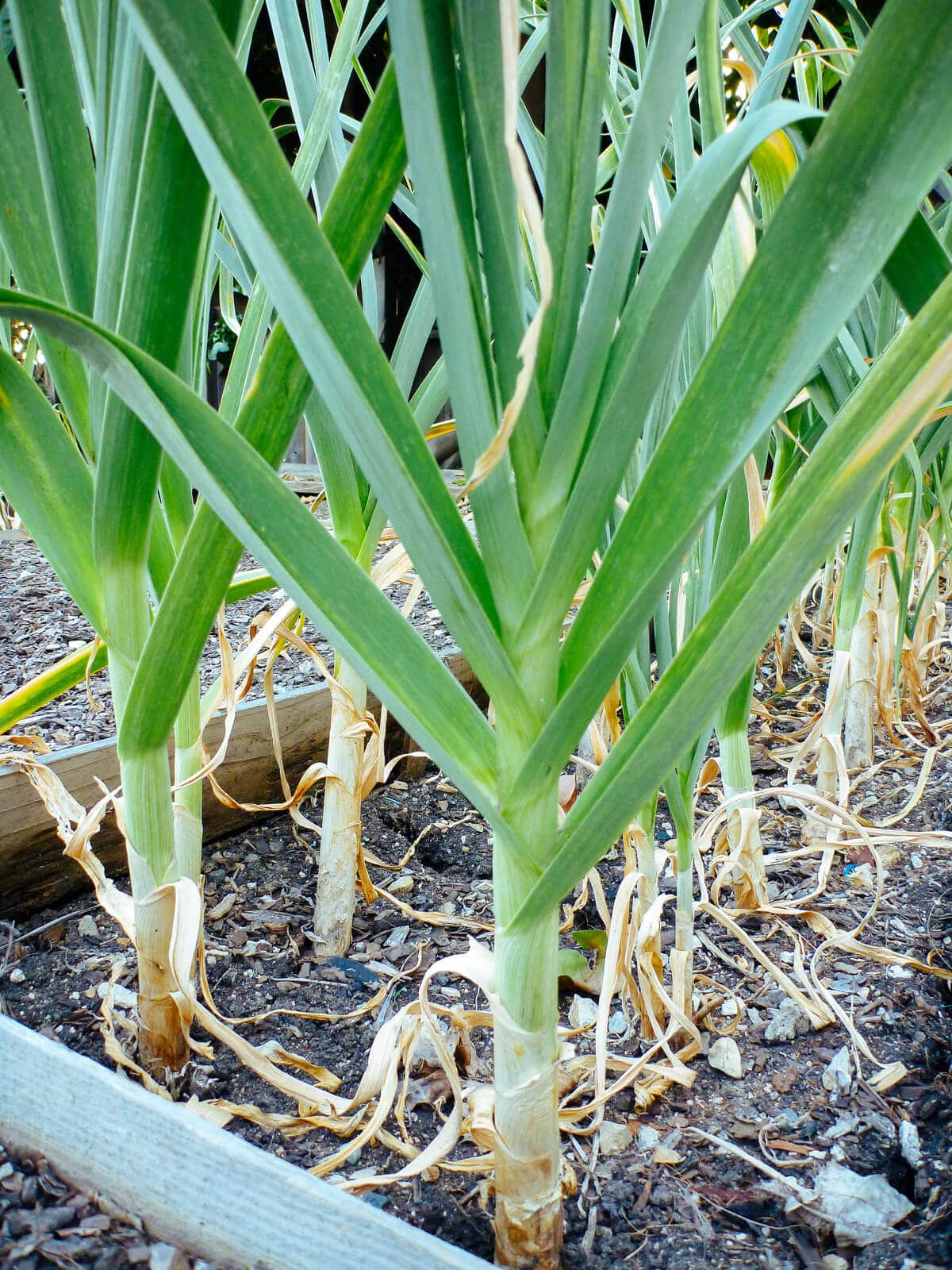
How do you know when garlic is ready to harvest?
Unlike its allium cousin, the onion, garlic matures when its leaves are still partially green. Garlic bulbs remain below ground during development, so it’s hard to know when they’re ready to harvest.
Onion leaves, on the other hand, begin to lose color and wilt when they stop growing. The tops dry up and flop over, telling you it’s time to harvest onions. Most onion bulbs have pushed themselves out of the soil and it’s easy to see whether they’ve fully matured.
So what’s the trick of knowing when to harvest garlic?
Look at how many leaves are left on the plant.
Each leaf above ground indicates a layer of protective paper wrapped around the bulb. A garlic plant with 10 green leaves, for example, will have 10 layers of bulb wrappers.
While there’s no standard number of leaves that garlic should have, a reliable harvest indicator is when half the leaves have died off, and half are still green. The leaves start to die off from the bottom up.
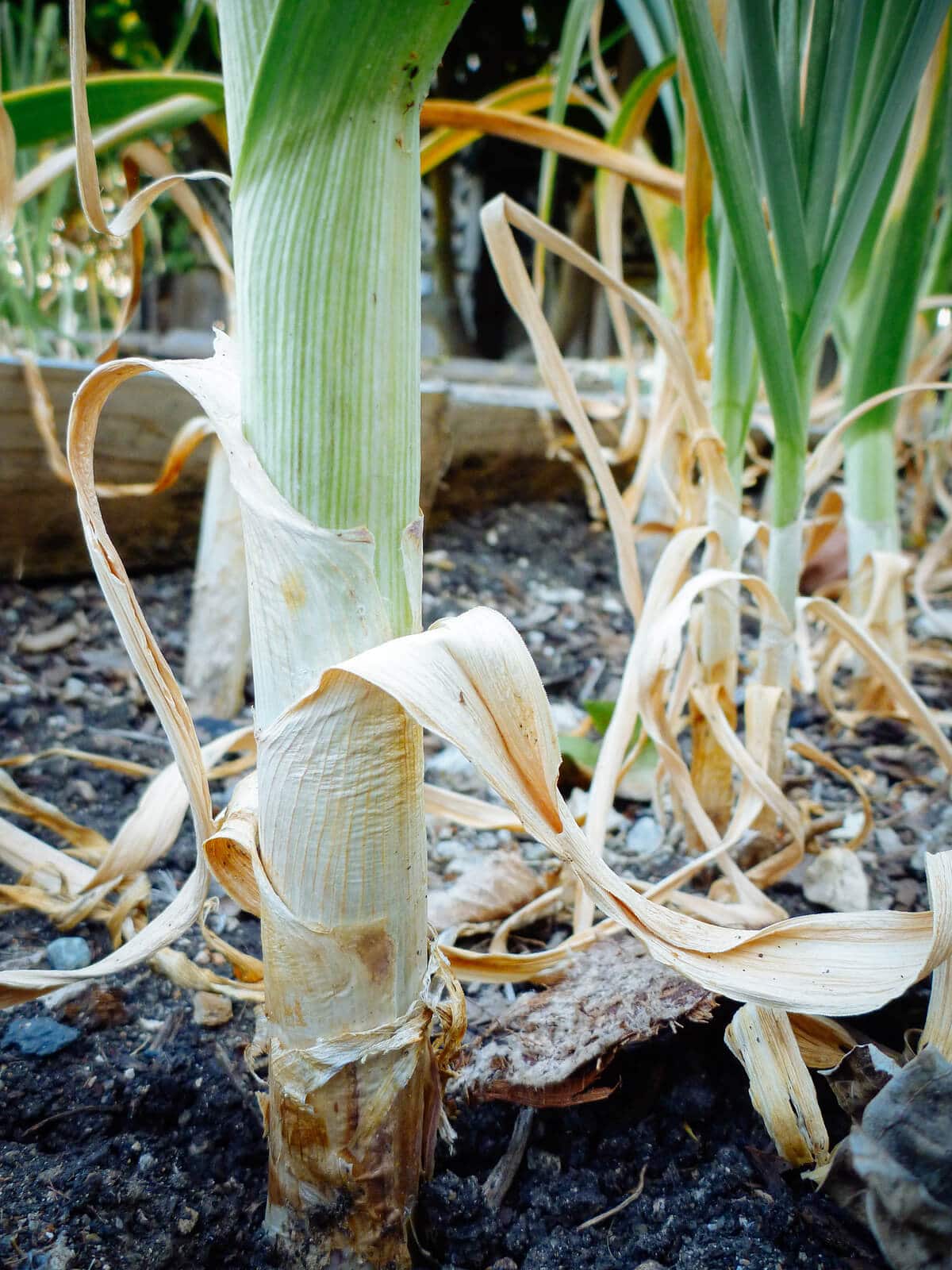
Just don’t wait until all the leaves have died back before you start to harvest. Without the bulb wrappers protecting the garlic head, the cloves may separate and the garlic won’t store well.
Here’s another trick for timing the harvest of your garlic: If you grow hardneck garlic, your crop will form garlic scapes about four to six weeks before the bulb is mature. Once you harvest the scapes, wait a month or so, then start checking the size of the bulbs.
When should you stop watering your garlic?
Continue to water your garlic as usual in spring, even as the leaves start to die off.
When at least 50 to 75 percent of your crop has reached the telltale stage of maturity—half the leaves are brown and half are green—stop watering your garlic for one week.
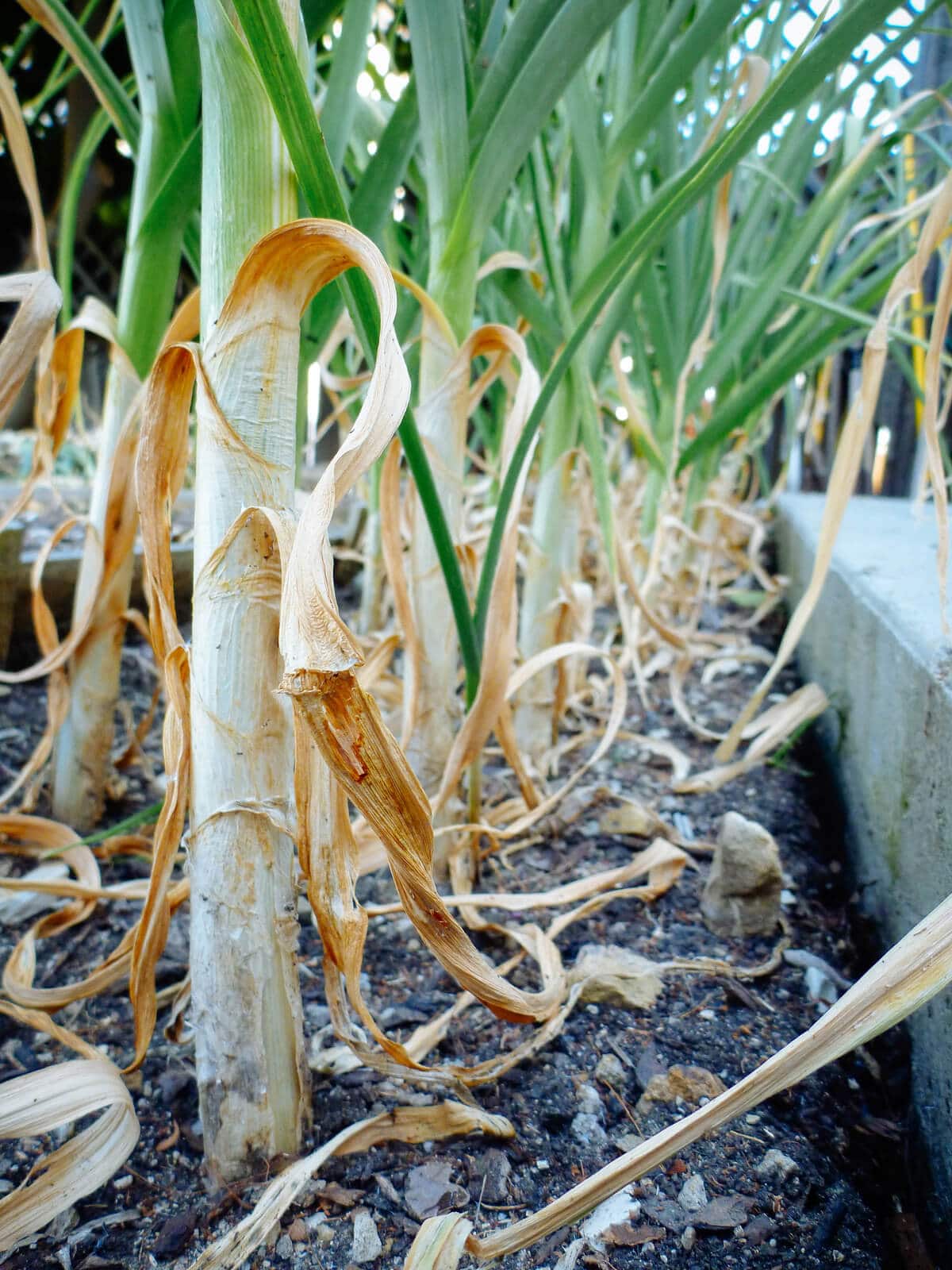
This allows the soil to dry out a bit to prevent rot, and makes harvesting easier if the soil is loose and crumbly instead of wet and compressed.
How to harvest garlic
First, do a pre-check (as I like to call it).
Lightly dig into the soil around a random bulb, or a few random bulbs (taking care not to damage any of the wrappers or cloves), and check its size without digging the whole thing up.
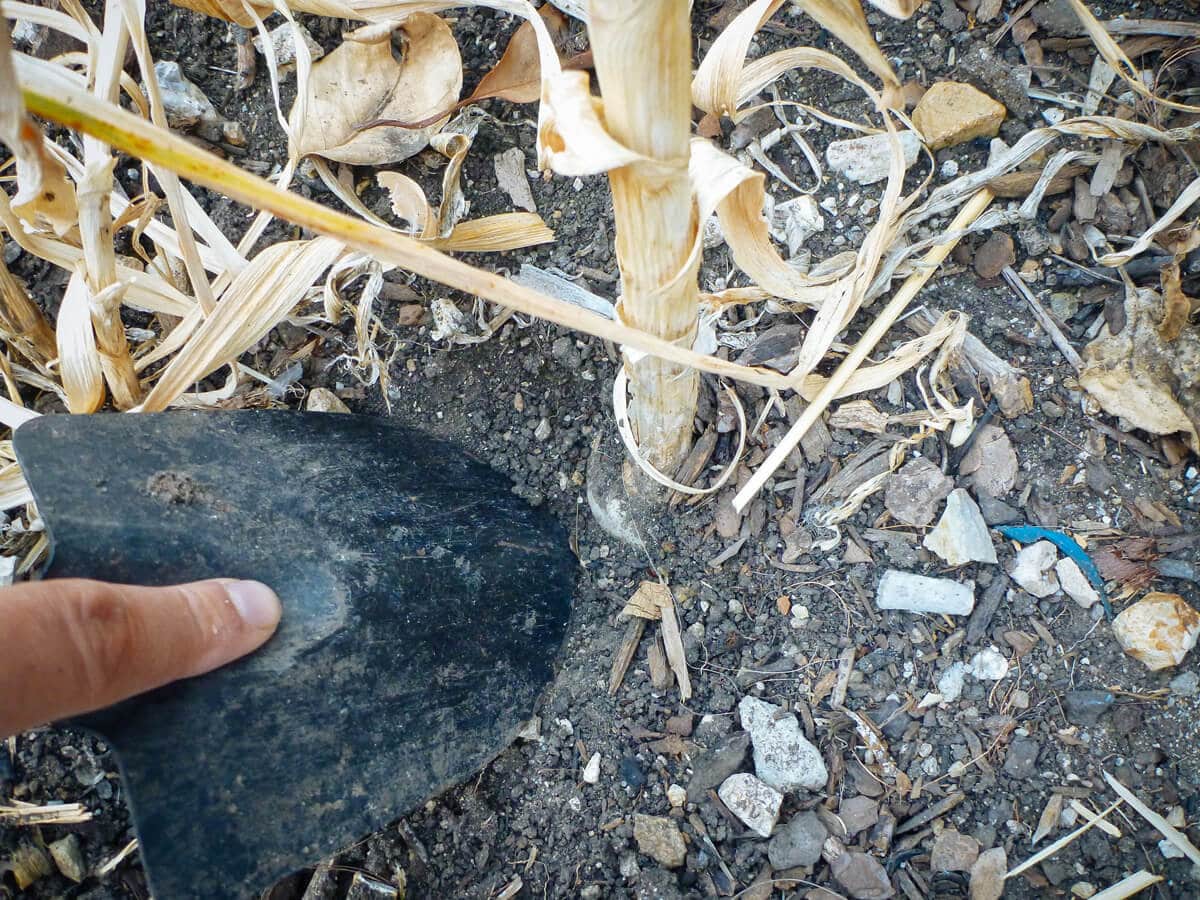
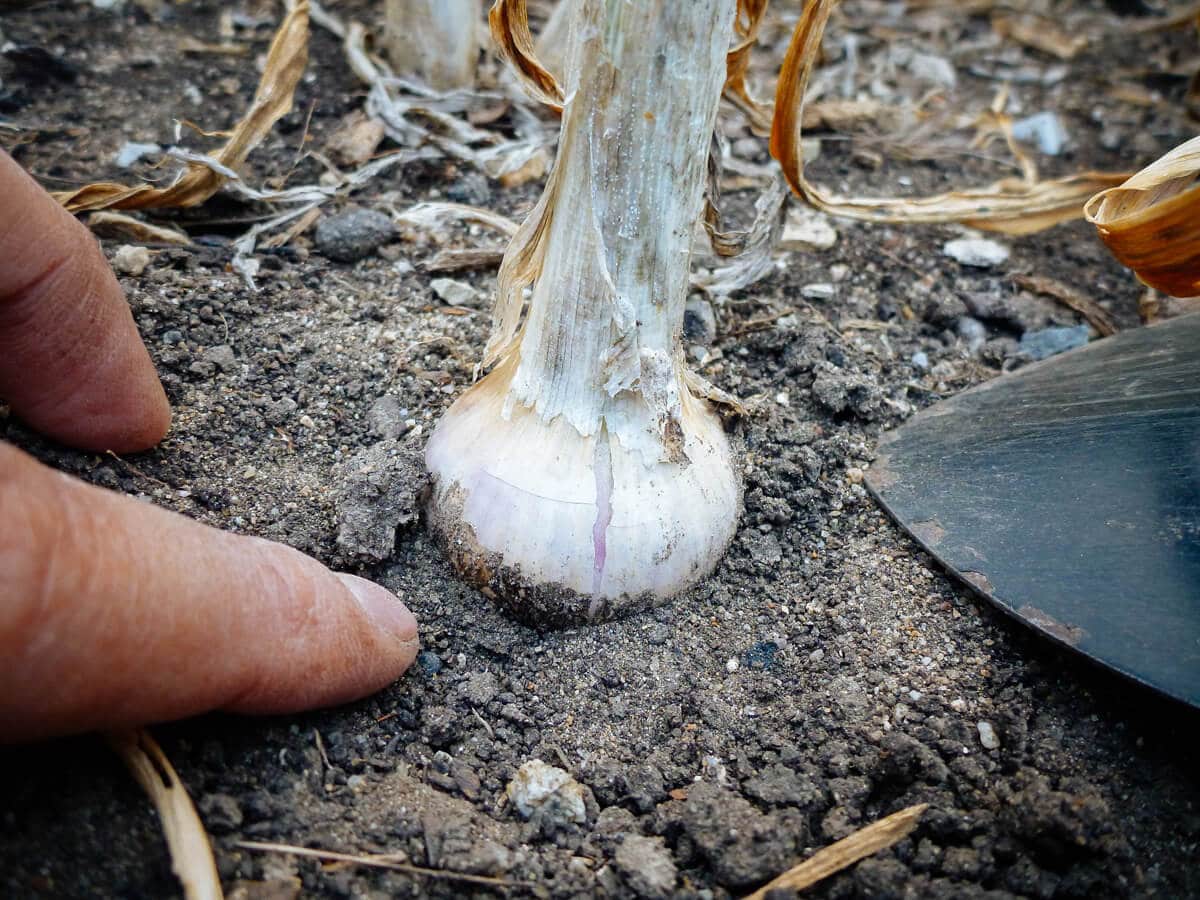
If the bulb looks small, pat the soil back down and wait a few more days before you check again. If the bulb looks substantial, the wrappers tight, and the cloves plump and well-formed, it’s ready to be harvested.
Carefully loosen the soil around your bulbs with a trowel and gently pull the garlic out from the base of its stem, at its neck. Brush off any excess dirt that falls off easily.

Should you wash garlic after harvesting?
Do not wash your garlic or remove the bulb wrappers after harvesting.
Washed garlic tends to accumulate extra moisture in the bulb that may lead to fungal infestations. It’s also additional time and effort that simply isn’t necessary, and I am all for efficiency in the garden!
From a cleanliness standpoint, most of the dirt sticks to the outermost layer of paper, which is also the layer that tends to shred and peel away during harvest. Once this layer falls off naturally, it’ll reveal a clean layer of bulb wrapper.
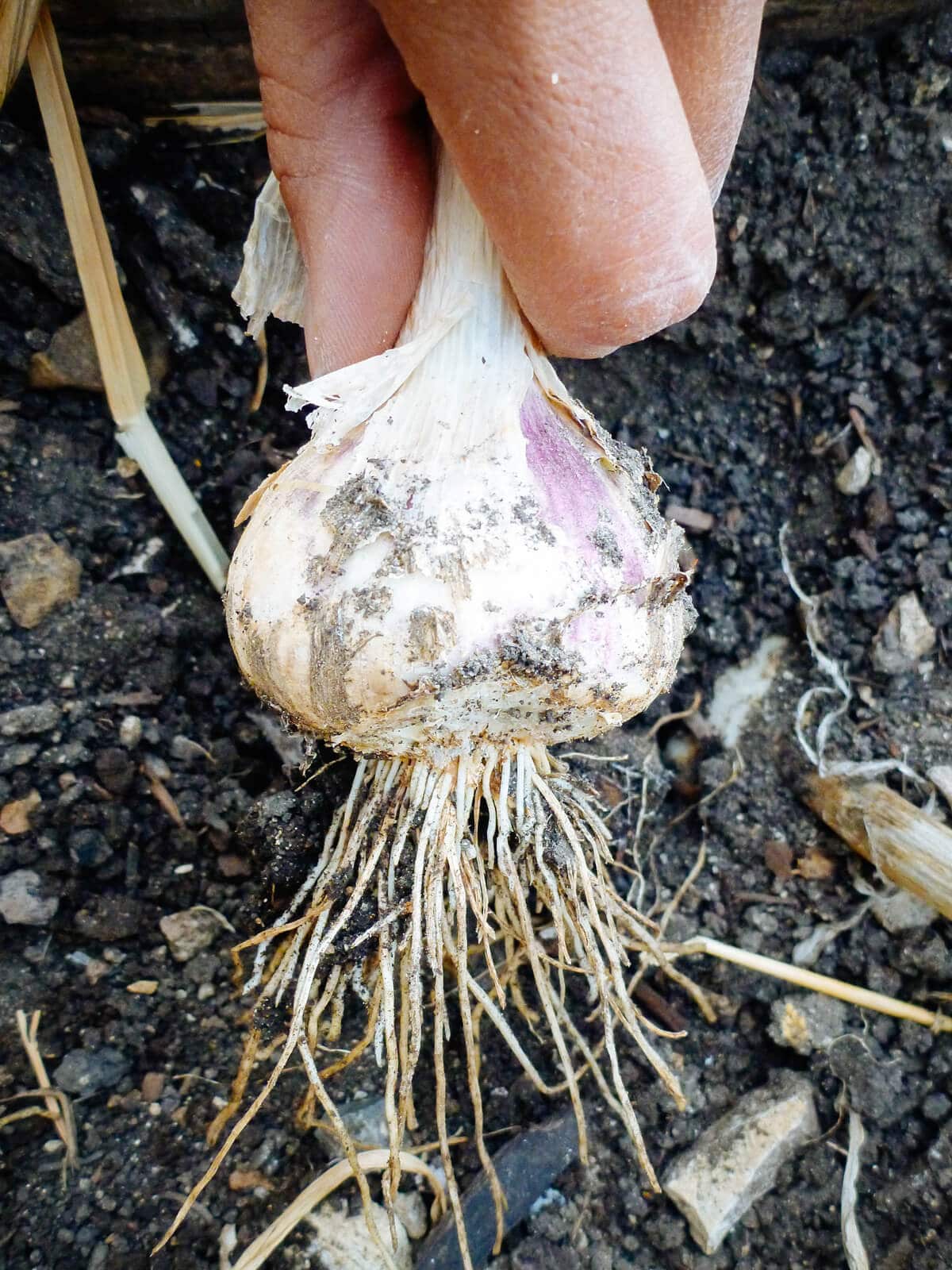
How to use and store garlic
If you plan to eat your garlic right away, use scissors to trim the leaves and roots so you can keep them tidy in the kitchen.
Do store the garlic at room temperature in a dark, dry place with plenty of air circulation, such as an open paper bag or wire basket in a pantry or cupboard.
Don’t store garlic in the refrigerator. Light and moisture are its worst enemies, and garlic stored in the fridge for a long period will start to get moldy or sprout.
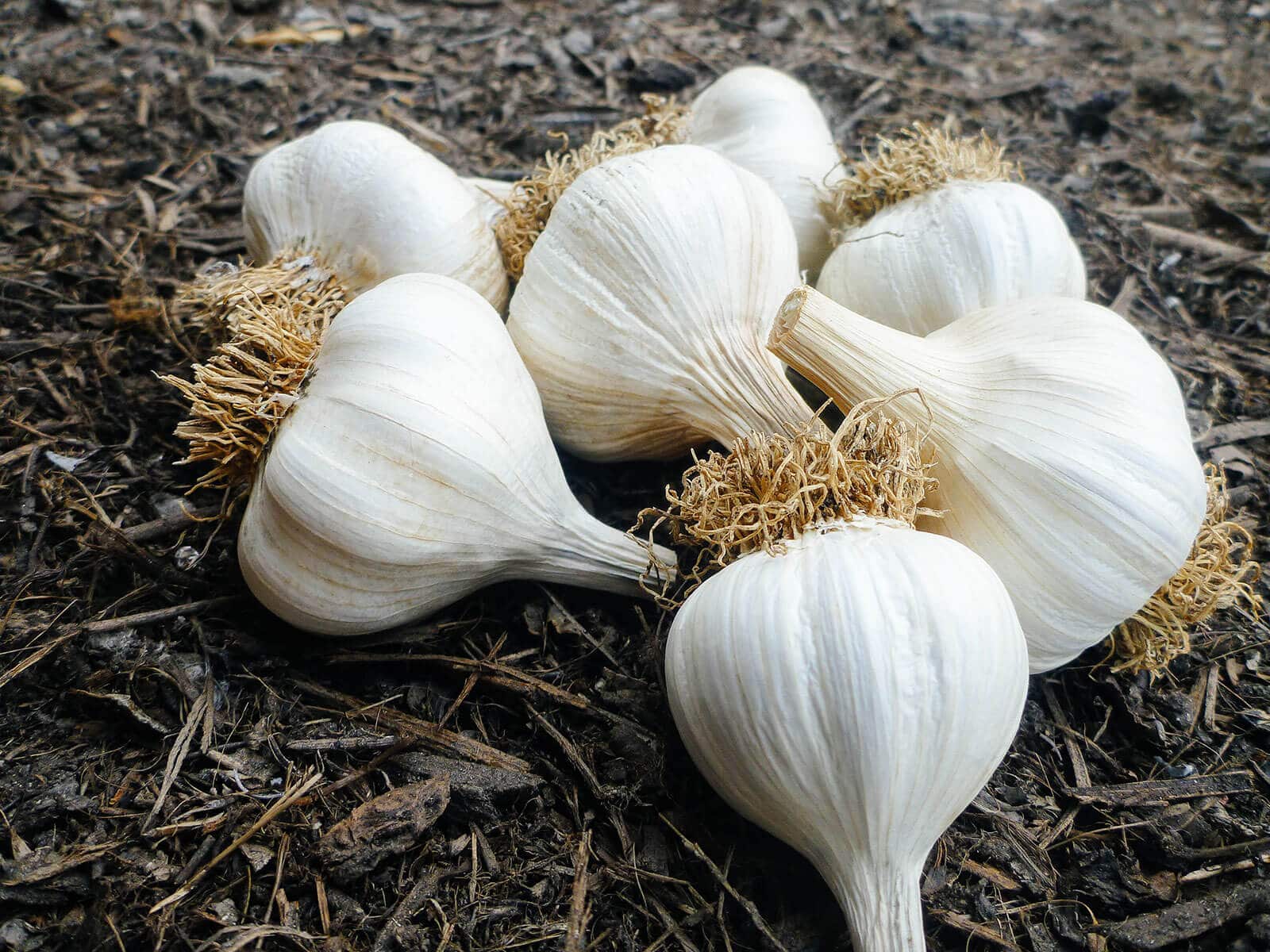
You should use the garlic within 3 weeks, or within 7 to 10 days once you break open a head of garlic. Any garlic that may have been cosmetically damaged during harvest (but are still edible) should be used first, as it’ll decline in quality sooner.
If you want to prepare your garlic for long-term storage, keep the leaves and roots intact and follow this guide for curing your garlic crop.
When do different garlic varieties mature?
Generally, Asiatic and Turban varieties of garlic mature first in the season (as early as May in some areas), while Silverskins mature last (in July or August).
There can be a six- to eight-week span between the time the earliest garlics are ready to when the latest-maturing garlics are pulled from the ground. Smaller plants often mature earlier than larger plants.
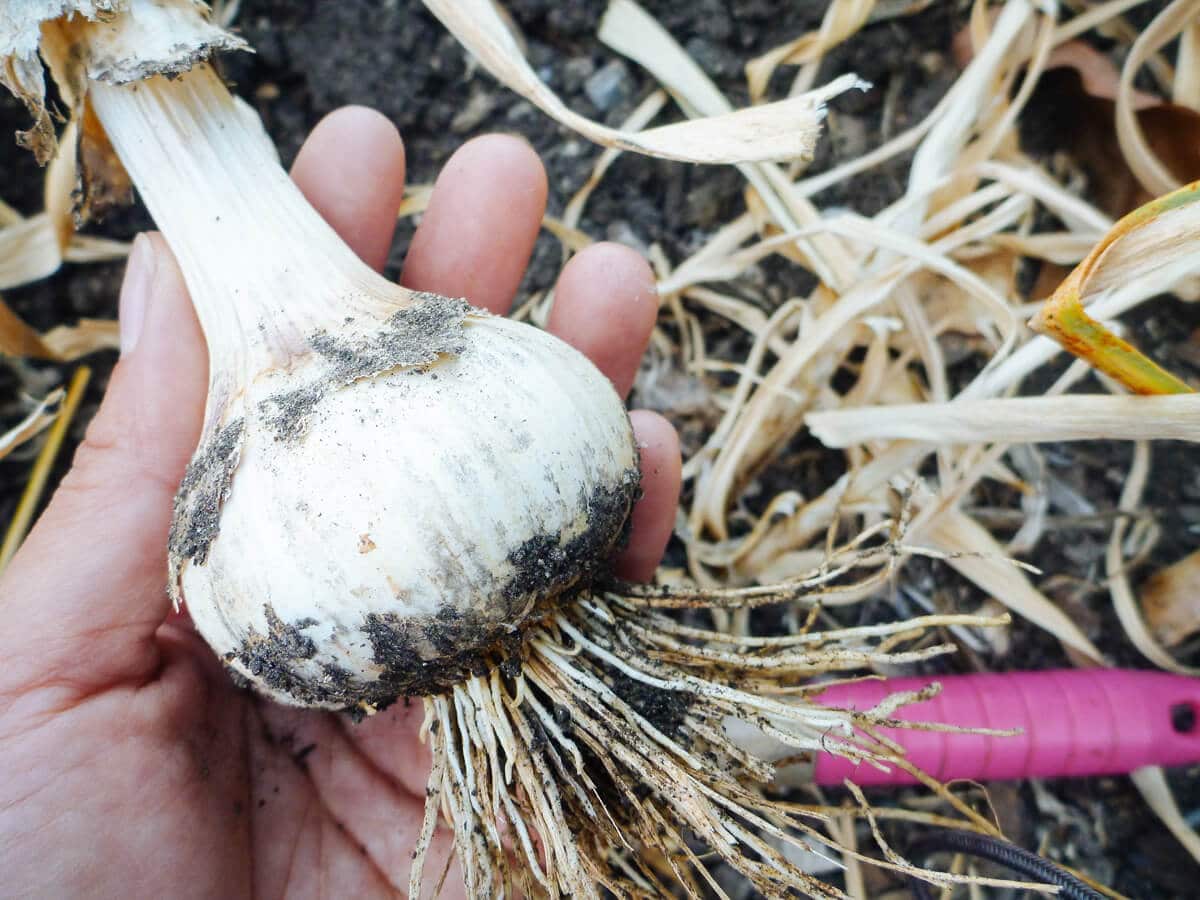
For example, I once planted Ajo Rojo (a Creole garlic) and Siciliano (an Artichoke garlic) in October in my Southern California garden, and both were picked about two weeks apart in late May and early June. These spring harvests are typical of warmer regions, especially for cultivars that are well suited to the climate.
In northern climates, harvest from fall plantings typically occur in late July to August.
In southern climates, harvest depends on the actual planting date.
Garlic Maturity Chart by Type
| Cultivar | Maturity |
|---|---|
| Turban | May to June |
| Asiatic | May to June |
| Artichoke | June to July |
| Rocambole | June to July |
| Creole | June to July |
| Glazed Purple Stripe | July |
| Purple Stripe | July |
| Marbled Purple Stripe | July |
| Porcelain | July to August |
| Silverskin | July to August |
Your harvest period is also determined by the current weather and soil conditions, so even if you grew the same cultivar of garlic this season, it may not mature at the same rate as last season.
Since there are no hard-and-fast dates to go by, the best way of knowing when to harvest garlic is to start paying attention to the leaves in spring.
What happens if you harvest garlic too early
Timing is important when it comes to harvesting and storing garlic.
If you harvest garlic too soon, the garlic bulb will be smaller and may not have fully divided into individual cloves. The bulb wrappers will be thin and will disintegrate more easily, leaving your garlic susceptible to rot or other damage.
If you have no choice but to harvest garlic early (for example, if you know you’ll be out of town), you can still eat the immature plants.
Very young garlic (called green garlic) can be stored in the refrigerator, and both the white bulb and green leaves can be used like green onions.
Garlic that’s almost ready (but probably picked a couple weeks too early) should be cured, with the understanding that it might not store as long as it typically does.
What happens if you harvest garlic too late
While you shouldn’t harvest garlic too soon, you also shouldn’t harvest garlic too late.
If you leave garlic in the ground for too long, the over-ripened bulbs will divide and form shoots from each clove (looking like a Siamese twins version of garlic).
The cloves will also burst out of their protective outer skins as they split apart, leaving them vulnerable to pests and diseases in the soil.
While overgrown garlic is still edible, it won’t last in storage and needs to be used right away.
But let’s say you forgot or missed a few garlic bulbs in the ground during harvest. That’s okay!
Garlic is actually a perennial vegetable and will continue to divide and regrow from cloves, year after year. The plants will start to become overcrowded after a couple of years, but this is a great way to keep a crop of garlic greens for use.
I actually have a perennial patch of garlic in my garden that I thin out every other year. It’s extremely low-maintenance as far as vegetable crops go, and gives me an endless supply of delicious, mildly garlic-flavored stems that I use like green onions.
If you can allocate a small amount of space in your garden, I highly recommend growing garlic as a perennial!
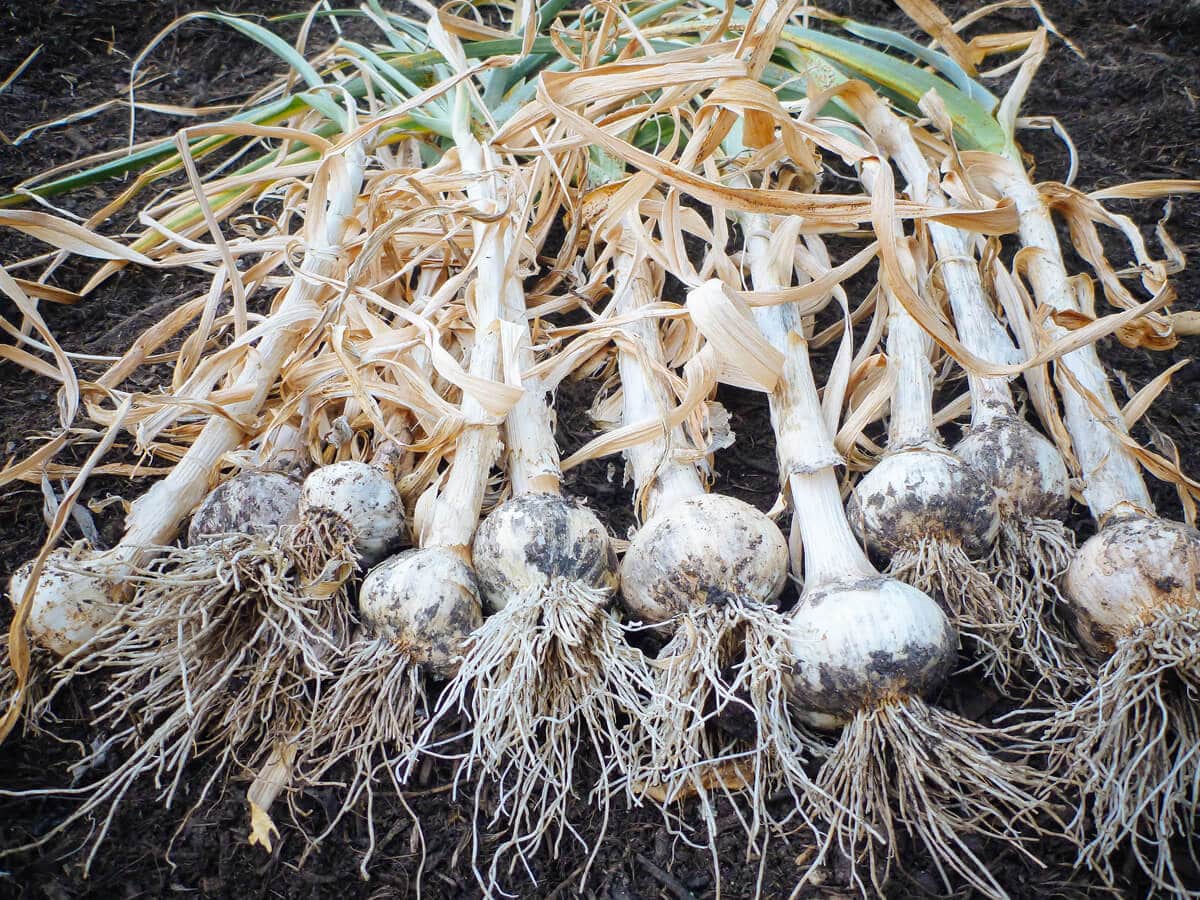
Common questions about harvesting garlic
Should I let my garlic flower?
In spring, hardneck garlics produce rigid flower stalks (called garlic scapes) that eventually lead to blossoms on the end.
While it’s not recommended to let them flower if you want good, robust bulbs, the presence of the garlic scape itself doesn’t seem to slow bulb development. A better option is to cut off the garlic scape when it begins to curl and eat it!
Can I use garlic right out of the ground?
Yes, you can use freshly dug garlic right away, raw or cooked. You can also eat garlic before it’s cured.
A good way to split your harvest is to set a handful of bulbs aside that you can eat within three weeks, then cure the remaining garlic so they’ll store for several months.
When do I harvest spring garlic?
Spring garlic (also known as green garlic or baby garlic) is garlic that was planted in fall, but harvested while it’s still immature. At this early stage, the bulbs of green garlic haven’t divided yet, and the crop is picked for its tasty, scallion-like leaves.
Green garlic can be harvested at any point in early spring while the leaves are green and tender. While some people grow green garlic as a primary crop, others use this technique to thin a densely planted crop in spring.
Here’s what to do next with your garlic harvest
This post updated from an article that originally appeared on July 9, 2011.
View the Web Story on knowing when to harvest garlic.


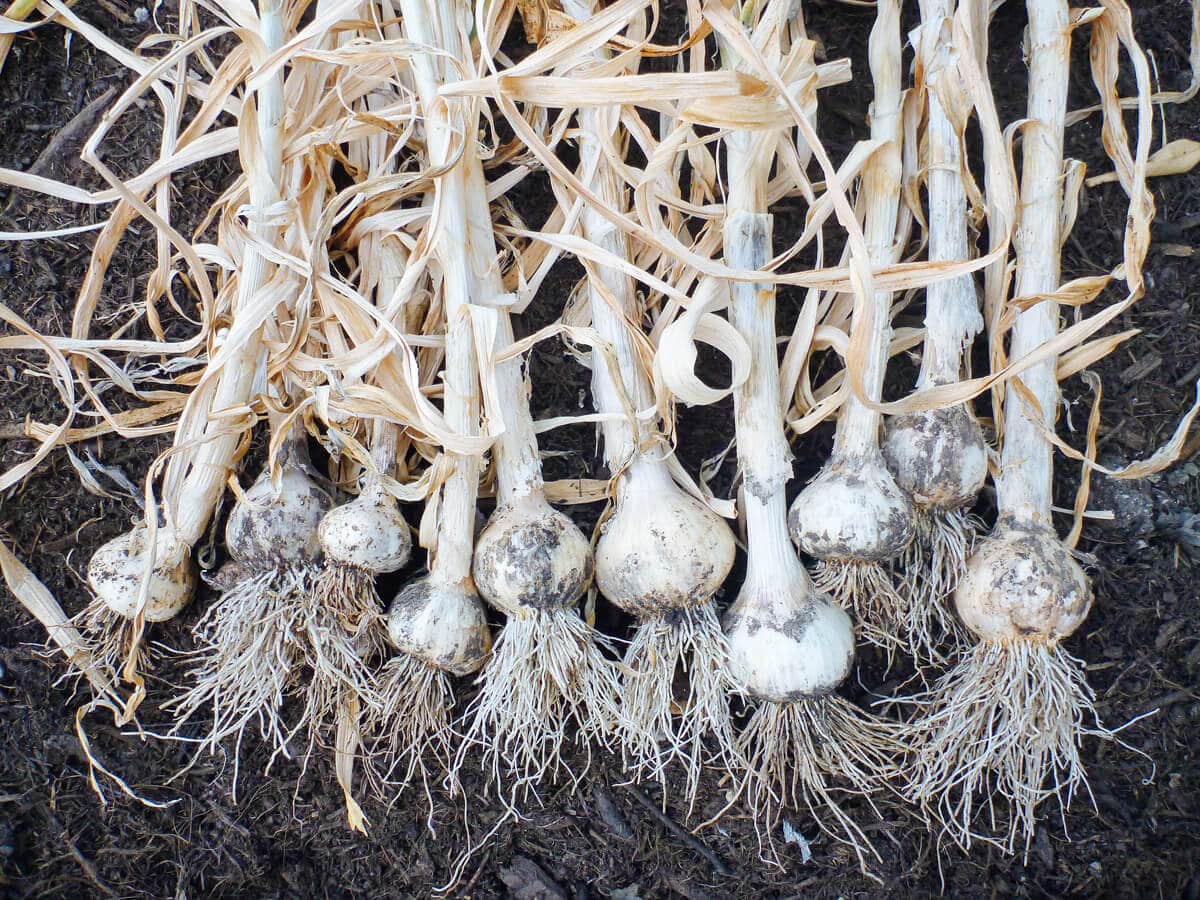













Thanks Betty
Thank you for this informative article. I want to know at how much days garlic crop has attained its 50% maturity?
And i planted garlic variety where its leaf tips were yellow from the starting stage of its sprouting what was the reason? and on maturity stage they turned black.
Different varieties of garlic mature at different rates, and also depend on when you planted and your local climate. You can refer to the chart in this post for the time of year your specific garlic is generally ready for harvest. Yellow leaf tips in early development could indicate overwatering or disease.
I’m new at growing garlic and this spring they had garlic bulbs in the garden section of store so I got a package and planted in a pot may or June will there be garlic or should I over winter them (look like small onions now )
plant your garlic in the middle of september or the 1st of october mine are still in the ground but will be getting pulled around august 1st
Hello Betty,
We planted seed garlic – Music – but have discovered we had another type in there. Reddish, more cloves then music, slender cloves, and when the plants start out the leaves grow outward along the ground, but once there are about eight leaves they grow up tall like Music. Can you tell us what type of garlic this might be? Thank you.
Planted garlic, do not remember the type) last fall. It sprouted leaves! Some eight inches tall before I covered with six inches of leaves and pine needles for winter protection as I am in NH. Once frosts were done removed leaves and pines needles. Nothing happened. Nothing has grown. What did I do wrong?
Just like your garlic, mine sprouted last fall as well after planting (it was warm late into the year). I had covered soil with thin layer of straw ~1″. No problems come spring. I think that you may have caused the sprouted leaves to rot (which spread to clove underground) by putting so much leaf and pine onto them.
I’m in Nh and now wait until the first week of November to plant Garlic.
One thing I learned about garlic is that if you plant it too early, it will start to really grow (like you described yours being 8 inches tall) BEFORE the Winter comes and, if it has grown too much, the Winter will kill it. The idea is for the roots to begin to grow before the winter and the mulch you put on top will help protect those roots during the Winter so when Spring comes, the plant (top part) can begin to grow out of the ground. Sorry no one gave you an answer earlier. I have read one should plant garlic in the fall about four weeks before the freeze but I have never tried to plant garlic in warmer climates (we are zone 3). Hope this helps. One more trick that most people do not talk about is scapes. Most people say to cut them off and eat them so the bulbs grow larger. One year I decided to cut the scapes off half of my garlic and compare the resulting bulbs to those that still had the scapes attached. While I did not use a micrometer, I could not see any difference in bulb size. What I did see is that each scape will contain several small “bulbules” which can then be planted and will grow into pearl onion sized garlics the first year and can then be planted (or eaten) the next Fall as regular seed garlic cloves. Last Fall we planted about 1000 bulbules which are growing and looking like grass in beautiful rows. We dug out some of them to see what they taste like and are fantastic and about the size of a pencil eraser so far. Hope you have better success each year.
use straw and use lot,s of good rich soil ‘chicken manure before you plant
I transplanted some garlic in Spring (not by choice). Should I harvest it then cure and replant in the fall?? Thanks!
You should harvest that spring-planted garlic for garlic greens: https://gardenbetty.com/growing-and-harvesting-green-garlic/
Hmmm – I planted mine in April. I guess it’s not the right season. Will i still have a decent harvest? Thanks, Bill
Your garlic seed won’t divide into cloves, but you can still harvest green garlic: https://gardenbetty.com/growing-and-harvesting-green-garlic/
Can you still dry and braid garlic that did not divide into cloves because of spring planting?
I planted mine in spring in the Northeast and I pulled one up today to check it and I have some nice size heads of garlic but they did not separate into cloves but they smell wonderful. I am assuming I can still dry them and then braid for the winter. This year I will plant in the fall.
I’ve just planted garlic and its been only 2-3 weeks. There are in total 3 leaves, of which one has bent and one is slight yellow in color. What do I do?
It’s hard for me to say. I’d guess you’re either overwatering or underwatering.
Then how do I decide how much to water? I’m not sure about these things. I’m a novice
Generally, I only water when the first couple inches of soil feels dry. After you water, it should be evenly moist but not soggy.
Garlic is very forgiving. Leave it alone.
I went to cut my scapes but ended up cutting more than scapes…..first time – so I ended up leaving 3-5 inches of the stalk with 2-4 leaves…..what do I do now? I planted in October – it’s now toward the end of june. Have great stalks which I will cut and use….but what happens to the bulb?
Since it’s close to harvest time, your bulbs should be fine. It just might be a little tricky to know when they’re ready to pick since you won’t be able to tell by the leaves: http://gardenbetty.com/2011/07/the-trick-of-knowing-when-to-harvest-garlic/
I planted my garlic last fall (SW Mich). I have a shoot on top that is kind of curling around and seems to be growing a head on it. Do I leave them in the ground yet, is that growth on top going to hurt the garlic bulbs? My first time growing garlic.
Hi! That shoot is called a “scape”. It’s the reproductive part of the garlic. Cut it off, chop it up and put it in stir fry or vinegar to use as a dressing. Once you cut it off, you will have a couple of weeks to a month until your garlic is ready to be harvested! O
I also live in SW Michigan, and my Music Garlic is almost ready!
Thanks Tara, I can hardly wait to harvest it!!!
I live in SW Michigan as well, and my garlic is almost ready!
Tara is correct, it’s a garlic scape and it’s delicious! http://gardenbetty.com/2012/07/garlic-scapes-are-good/
Well, its a SW Michigan get together!!!! I’m currently growing 20 varieties of garlic in SW Michigan. My goal is to find the ones that grow best in our climate. It’s my favorite crop to grow that’s for sure! Those scapes taste great in a simple pesto recipe. Spread it on bread for garlic bread or over some noodles. We also make scrambled eggs with scapes chopped up in them.
It’s July 8 now and I’ve harvested half my varieties. I’m very happy with a few and then a few others did not size up well at all for me. I might give those another year and then remove them from my arsenal if they show no signs of improvement.
Thanks for the article and good info
I have only pulled one of mine from the ground and it was very small. I do not know what kind of garlic it is. Bought it at the farmers market and being such a novice didn’t think to ask what kind it is. Hoping the remainder has gotten some growth on them.
We planted garlic last November and we got really busy this summer. We never had time to harvest all of it. Now it’s November 1st and the cloves in each bulb have sprouted. Can we leave the bulbs in the ground until next summer? Or do we need to harvest them now and then what do we do with the sprouted cloves?
It’s highly unlikely the sprouted cloves (now seed garlic) will form good bulbs by next summer, since they’re too crowded. They are best harvested and used as soon as possible, since they won’t cure at this point. You can eat the sprouts – often times, I plant garlic in spring just for the greens: http://gardenbetty.com/2014/06/growing-and-harvesting-green-garlic/
You can also dig up, separate, and replant the sprouted cloves for the next crop!
I always store it in a canvas shpping bag. All but last year it keeps great. Last year i hung the bag in a closet and i believe that is why it didnt keep as well.
I have a few more suggestions for storing garlic in this post as well: http://gardenbetty.com/2011/07/a-guide-to-curing-and-storing-garlic/
I live in Western NYS and have planted garlic for years. In these parts, Bastille Day (July 14) is the day to harvest the garlic. I store my garlic in my basement and no matter what by early April it starts to rot. I read a few months ago to store the garlic (about 6 bulbs each) in small paper bags with holes punched in it. Has anyone ever tried this? I hate losing any of my garlic, but worse than that is buying garlic in the grocery store; it has no taste.
Hi , I also live in WNY – Rochester. I planted my first crop of garlic in October. When do you plant it that it is ready July 14th? Thanks!
Most northern climates should have garlic in the ground by the first frost (no later than early November). It takes about 8 months to mature.
Ainniz, I have been planting garlic for 18 years. I haven’t found fool proof method for storing garlic. Have tried storing cool and storing warm. Tried hanging in small bunches etc. What I do now is at first of the year, peel all garlic while still very firm. Put in food processor and mince. stores in fridge for months, with good flavor. If need to add some good olive oil while mincing.
Try to dry in the soil dont pick early
I wrote a post here with tips on storing garlic: http://gardenbetty.com/2011/07/a-guide-to-curing-and-storing-garlic/ Keep in mind that certain varieties of garlic keep longer than others.
I use a paper punch and punch a lot of holes in a large paper grocery bag and store my garlic on the top shelf in my pantry. It works great.
I save all my mesh bags—-from oranges etc–I planted in oct at 2 week intervals and just cut the scapes in june—-in surrey BC
Hi there. Thanks for a helpful post. I planted garlic last fall for the first time, and most of them look like they’re doing beautifully (it’s now early June). One however seems to have had its top completely lopped off by a squirrel. Should I pull it out? Or can it survive without its top greenery?
Apologies for the late response to this question, but for future reference, you should pull out any garlic in that situation and use it right away. It will not continue to grow without its leaves.
Interesting post, thank you.
I’ve grown a fair amount of garlic, but never heard about the bulbs dividing and sending out separate shoots before. Can you leave a bulbs in the ground each year to keep dividing, and raise them as a perennial crop like multiplying onions?
I suppose you could, but the bulbs might not grow that large.
I have had garlic in same place for 36 yrs. + the bulbs are large. I live in the south. I have no idea what the name of the garlic is. This garlic comes up around January and then it will have large seeded blooms. I was told when the blooms and leaves turn brown and fall over, it’s time to harvest it.
This sounds more like elephant garlic. We just learned about it last year in our new home as there is plenty of it around. It self sows and frequently has little offshoot bulbs connected by a little string like fibre…. it has a mild garlic flavour but is not actually garlic. https://en.m.wikipedia.org/wiki/Elephant_garlic
I have an extensive garlic crop growing, and, I am waiting, but, I have found in my climate, you just keep planting it, and you will get a crop throughout the year. I do use the leaves often in cooking. They are sweet, sharp and have the good garlic flavor, so, to me, the plant can be utilized before harvest. And, to germinate the cloves is easy.
Stagger the planting, and over time you can have an abundance of garlic.
Hi am real new to garlic planting, am curious as to what area you live in and am hoping I can as well because I don’t want to have to wait 8 more months till October. I live in California zone 9. In your experience would my climate be suitable for year round garlic planting and harvesting?
Hi. What I am doing is always germinating cloves to plant at any time of the year. I live just south of the SF bay area, so, it’s a good climate. You have to wait though as the winter months have less sunshine and the angle of the sun in relationship to the Earth is such that any obstruction, tree, fence, etc, limits the available direct sunlight.
So, the time to harvest does vary. Now, if you want to get your garlic ahead of things and know if you have a viable plant, do this. Get the very thin kebab skewers and take single cloves, with the skin on, and rack them up. Now, get them about 3/4 submerged in water, the skewers holding them up, and wait until you see a green shoot come out of the top. You will also see definite roots. These will grow 90% of the time.
The garlic capital of the world used to be, Gilroy, CA so growing garlic in CA should be a breeze
I did transplant some of the garlic from a big pot to a garden soil. That was a death blow! I harvested some, but, I am disappointed. However, I just keep germinating the cloves. And, the key is keeping them in the same soil. So, the really healthy ones failed….But, I have to admit….There was a large cat that decided to choose this area for napping!
Oh well…….
Been planting the last couple months (it’s almost June). I live on San Diego and it’s such an easy plant to raise. I trim and use some of the stems in cooking too and it’s yummy.
Garlic leaves are one of my favorite things to cook with! http://gardenbetty.com/2014/06/growing-and-harvesting-green-garlic/
It’s my second year planting garlic. What amazes me most is the number of crops you get off of it. Early in the year the leaves start growing, my grandaughter and I chop them off all the time and munch them raw. I use them in my scrambled eggs, with purslane and lamb quarters all early summer until the scapes come, then it’s scapes raw, scapes and eggs, scapes on sammys, scapes in pesto. Then the bulbs come, it’s time to finish up the leaves and start munching on the cloves. Pick the best ones for next years planting and start all over again. It’s the most giving plant I have in my garden, and to say nothing of it’s curative properties.
I love your top-to-tail use of garlic. 🙂 It’s one of the best crops in the garden, for sure!
You’ve uploaded some good posts thanks Linda. Down here in New Zealand I’m monitoring my garlic crop closely, and I reckon I will probably harvest it within three weeks. I’ve grown the same type of garlic for a few years now (don’t know the variety name sorry), and I’ve noticed that the plants look a bit weatherworn long before the bulbs are fully developed. Nevertheless I generally get a good harvest. I pick it all at the same time and I can find some bulbs that aren’t quite fully developed, and some in which the cloves have started to separate. So we eat the over- and under-ripe garlic first, and the rest can keep in a cool place until around the time of the next harvest … although a few cloves will have sprouted or gone mouldy by then. Best wishes from Nelson, New Zealand… Stephen Coote.
Hey Steve,
Been and lived in NZ. What else are you growing?
G’day Ross. We live on a small property. We have fruit trees, some espaliered, including apples, plums, peaches, citrus and feijoas. We have a couple of grape vines and some blueberry bushes. I love to grow tomatoes in the season. It is winter here and we are picking lettuce, rocket, kale, swiss chard, parsley, mint and the leaves from some young broad beans. Our parsnips look like they are just about ready, and there are a few carrots left. I planted the garlic about six weeks before the shortest day, and it is looking very good. I am fortunate to be able to harvest wild meat from the neighborhood. I’ve caught about five feral pigs in my home valley this year so far. Where do you live now Ross?
Oh, I spent plenty of time on the South Island. I live in Campbell, California. So, we get some mild weather. I knew a guy who had a ranch outside of Tauranga. But, he was a sheep and cattle guy. I also was a chef, or cook, for a Bed and Breakfest in Methven,,,,
I have a whole bunch of things growing that are coming to fruition, and some that have bolted. I don’t mind that, because the seeds are there for the germination for the next crop. But, the plants focus more on the flower and less on the leaf. But, you get the seeds.
Farming is patience……As is life.
Could you please tell me how to store my garlic , once it’s been harvested?
Hi, I wrote a post about the curing and storing process: http://gardenbetty.com/2011/07/a-guide-to-curing-and-storing-garlic/
I bought a house that has garlic planted they are tall and have green balls with a leaf over them. DO I dig up the inground garlic or eat the tops only? If I dig up the bulbs will they grow next year or do I have to replant?
I’m not sure what you mean by green balls, do they look like flowers? Hardneck garlic will often send up flower stalks that are tall and stiff. You can cut off the flowers and eat them, if you wish. Only dig up your garlic when the leaves indicate they’ve matured enough. If you aren’t sure, you can lightly dig around the base of the garlic to take a peek at the size of the bulb. After harvesting, the garlic needs to be replanted.
Do I have to replant the ones I dig up? The whole bulb or just one piece of it? What position and when do I plant if for next year?
Here’s a guide I wrote on growing garlic: http://gardenbetty.com/2010/10/growing-garlic/
This post was perfect for information content. Now, how do I deal with the moles that compromise the root system of some of my garlic??!!! Grrrrrrr…
Sticky traps around your beds . they especially love pepper plants and lettuce I have found . So wht i do is set a lettuce with 4 sticky traps and eventually you will catch one .
To keep em away entirely , use grounded Cayenne pepper spice , they hate this stuff and will keep away . works for deer and other veggy loving pain in the butts .
Got rid of moles, gophers, any other underground critters, by purchasing dried Fox urine! Sprinkled it all over the garden. They fear the fox, and just leave quickly! Worked for me! Lol
I have had them in the garden for 3 years now and they seem to be no where ready yet, just dug one out and its like a anorexic spring onion
Assuming you started the garlic from full-sized cloves, it shouldn’t take over three years for them to grow. Maybe there was a lack of sun, not enough spacing between the plants, or your cloves came from a warmer climate and were planted in a colder climate (so they haven’t acclimated).
Just harvested garlic that was left in the ground too long. There isn’t any protective paper wrapping. Would I be able to freeze these cloves in oil? Do I dry them first, or process them right away? Thanks,
Jane
You can freeze them right away. Personally, I’d chop them up before freezing in oil so that they’re ready to use when you need them.
Linda YOU know your stuff. Everything you have said is 100 percent. Thank YOU
You’re welcome! 🙂
Does the “top flowers” have anything to do with the timing of the harvest. Please advise. Also, FYI, I have two types of garlic that grows along a portion of my yard. The first produces a large bulb. I never plant this particular garlic, yet it appears every year for the last 25 years. Some years will produce more than others, though it has not failed me during the mentioned time frame. A second includes an Italian garlic that produces a smaller bulb that is red in color. This garlic is much more zestier, and is a product of seeds that I tossed along the area six or seven years ago. Like the initial garlic, the Italian garlic also appears every year, after harvest, w/o replanting. My neighbor who is no longer here, once referred to the first garlic described as a natural garlic bed, after all my years of harvest, I guess my question is is a “natural garlic bed” possible(?). Thank you for your time and consideration.
Some types of garlic form bulbils, which look like tiny cloves of garlic, and reseed in that way. The garlic “flowers” you’re seeing are the mature garlic scapes, and when they “bloom” they’ll drop bulbils in the ground that eventually grow into new garlic. Bulbils take much longer to produce a head of garlic than cloves do, but you probably don’t notice since they’re always producing. The constant reseeding is what’s creating this naturalized garlic bed.
You can actually cut off these scapes before they bloom and eat them before the bulbs are fully developed; they’re delicious and taste like a mild, crunchy garlic: http://gardenbetty.com/2012/07/garlic-scapes-are-good/
I was told garlic only sends up a scape and flower in the second year of a two-year cycle, so if there’s a scape, it’s too late to dig up the cloves. Is this true?
If you plant cloves of hardneck garlic in fall, scapes will appear in spring and you can harvest the bulbs in summer.
Exactly the info I was looking for 🙂
When the scape appears cut it off. if it is allowed to form the bulbs will be smaller. All of the energy sent to the plant will go towards forming the scape or seed bulb on top. WE have a section where we just let the garlic grown that garlic IS USED FRESH WHILE WE ARE WAITING FOR THE STORAGE BULBS TO FORM AND GET READY TO HARVEST.
On most garlic , when the scape loop starts forming , you must top it off , otherwise , the plants energy is focused on flowering instead of producing nice sized bulbs .
Did you plant garlic that was bought at a store , like a chinese variety ? If so , maybe the genetics are not accustomed to our weather and climate .
I bought my first garlic sets off a mennonite organic farmer a few years ago from my immediate area , and all i can say is WOW great genetics and quality and the taste is second to none , Maybe you should try the same .
Hi thanks for the info… totally new at this and now my garlic plant is curling up with several strands in the center, is this what you call looping or scapes? Is a flower going to grow there next? Planted it in fall in So. Cal. Zone 9 or 10? Hearing different advice on this? Also I was plucking some of the long green thin leaves and eating them raw and now some of those leave ends are now forming a kind of dry blunt end to them? Please anybody Help?
Thank you, this has been very helpful. It is my first year growing garlic and the pictures sure did help.
You’re welcome. Enjoy your first harvest!
I want to grow some ginger and garlic in containers on my deck. Will garlic to well in containers?
Yes, they make great container plants!
I found these instructions, and especially the close-up photos, the most helpful and clear directions ever. I now understand that I should have pulled my garlic last month, but didn’t. So, should I just leave it in the ground for next year, take it up and replant in October, or what?
Thanks
You should harvest all of your garlic now. Bulbs left in the ground will continue to divide, and you’ll end up with a clump of nothing but tiny cloves.
I agree with you about this article…excellent
Thank you!
That was the worst advice eer I pulled my garlic WAY to soon
I follow these guidelines for all of my garlic harvests and they have always been successful. Remember to check your garlic bulb BEFORE pulling it out. If you find it too small, you should leave it underground longer. And if you planted garlic in the spring (rather than last fall), you’ll usually end up with much smaller bulbs, if they divided at all.
I planted about 10 garlic sections roughly two months ago in april. I planted them in a container, about a foot long and half foot wide. This was just planning on being a trial run. Only one ever grew a sprout, which grew about 2 inches. It looked nice and was growing well and then suddenly one day it looked like someone had pinched it at soil level almost totally off an within two days it was completely shriveled up and dead. Does this mean the one particular garlic plant is completely lost? Is my whole bunch lost? I don’t understand what went wrong with any of them. Thanks
The garlic that died is completely lost. The others that never came up have likely rotted in the soil; it should not take 2+ months for a clove to sprout. Hard to say what might have caused your crop to fail, as it depends on many factors: the quality of the seed garlic, the moisture of the soil, even the planting depth of the cloves. Sometimes, store-bought garlic will be treated with a chemical that inhibits sprouting.
I have a quick guide for growing garlic here: http://gardenbetty.com/2010/10/growing-garlic/
Thank you so much for the speedy response!! I really appreciate it. God bless!
garlic needs to be planted in the fall (oct) and harvested in summer (july) here in zone 8. I have an extreme slug population and They will chomp on them fast in the spring. maybe a slug or other bug ate your garlic? 😀
When you harvest anything may depend on which climate zone you two live in. Things get ripe at different times in different places. Are you in the same climate zone?